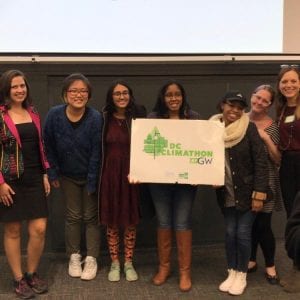By Jillian Webber
I was a freshman when GW Composting began as a university-sponsored pilot program with the uncertainty of progressing even into the following semester. Launched in February 2018, this program was run by interns at the Office of Sustainability and Campaign GW, with weekly Friday collections in Kogan Plaza. (Alex Rubenstein covered this story back in 2018.)
Intern Colin O’Brien drove much of the effort to begin this program, as well as trained a group of interested volunteers in January. I began collecting compost in my freezer and participating in the program, volunteering when I could. These Friday collections were very successful, amassing over 2,400 pounds from February to May and seeing an average of 36 participants each week.
By that summer, GW Composting hit the ground running as a permanent program, headed by intern Jonathan Kvilhaug.
During Fall 2018, the program collected over 3,400 pounds with an average of 46 participants each week, showing an increased awareness of the program and expansion of the compost community. I volunteered with Jonathan many Fridays, often helping him set up and staying until other volunteers arrived. The program continued to have plentiful volunteers after partnering with sustainability service courses.
The success continued into Spring 2019, with increased participation of graduate students and university departments, as well as expansion to GW’s Mount Vernon Campus. This semester totaled upwards of 3,500 pounds with an average of 58 weekly participants, both notable increases from prior semesters.
In Fall 2019, the program was run by intern Brianna Reynolds and achieved success yet still, collecting over 3,600 pounds that semester. Additionally during this semester, Student Association VP for Sustainability Jan Nowak gathered numerous composting stakeholders, including members of the Office of Sustainability, Residence Hall Association, and Campaign GW, as well as myself, to discuss expanding GW’s composting infrastructure. Soon thereafter I began working for the Office of Sustainability and Zero Waste Department, and was tasked with developing the new Residence Hall Composting Program.
This program is set to begin as a pilot in three residence halls on campus and provide composting convenience as well as encourage students to become involved with the composting community. Student volunteers in each pilot dorm will serve as monitors for bin contamination and student participation. The goals of this program are to increase composing awareness, expand composting accessibility, and have self-sustained, contamination free composting residence halls. Additionally, through my Zero Waste position we were able to begin expanding compost collections to GW events, the first of which was with the law school in March 2020.
Implementation efforts for the Residence Hall Compost Program and event composting were halted due to the pandemic. However, campus composting did not stop altogether!
In Fall 2020, I have been working with intern Natalie Wright to collect compost in Kogan Plaza every Friday. We have seen great success despite the public health crisis and an extremely limited number students on campus. To be successful this semester we have operated outdoors, worn masks and gloves, and always ensured our participants are wearing masks and practicing social distancing. We had 172 unique participants and a total of 4,750 pounds of compost for both Fall 2020 and Spring 2021, substantial numbers given the circumstances. We have utilized Instagram to expand our audience, educate on the importance of compost, and share what can and cannot be composted. One of my favorite aspects of this semester has been the immeasurable bonding with different folks during this tough quarantine period. Even Anne LeBlanc, the wife of GW’s President, composts with us! Compost education and fostering an inclusive community are two of the most important aspects of my compost journey at GW.
I will graduate in a matter of days and younger sustainability changemakers will take the infrastructure and participation to new heights! I see the future of GW’s composting expanding to the residence hall program, increasing collection opportunities in Kogan Plaza, catering compost bins at campus events, developing front-of-house composting in District House and other university vendors, and more. Building on past composting iterations is what has allowed us to come this far, and hopefully that trend will continue. Whatever it may be, I am excited to see the difference students make!



